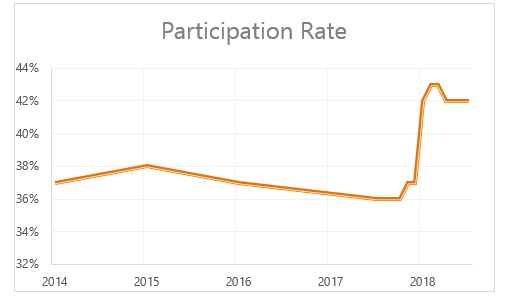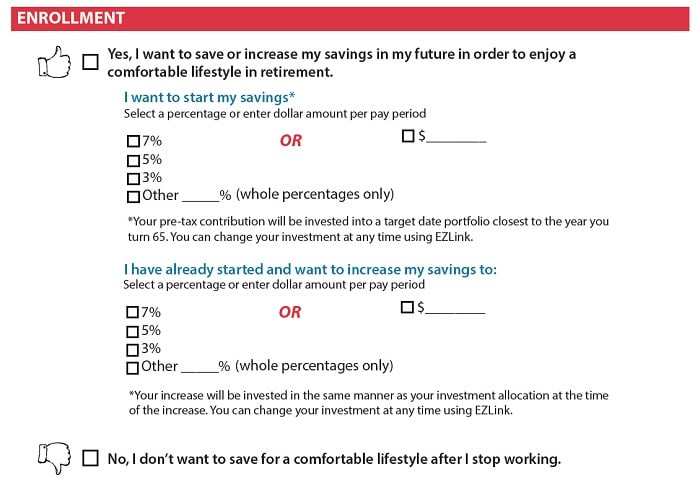 Active choice is a way of presenting a choice that requires participant engagement. (Photo: Shutterstock)
Active choice is a way of presenting a choice that requires participant engagement. (Photo: Shutterstock)
Choice architecture is the practice of influencing choice by changing the way options are presented to people. The concept was highlighted by Richard Thaler and Cass Sunstein in their 2008 book Nudge: Improving decisions about health, wealth, and happiness. As a plan sponsor, you may frequently find yourself in the role of a choice architect. Your job is to present participants with choices: participation, savings rate, investment options, education opportunities, and more. The way you present these choices can have a substantial impact on participants' experience and outcomes.
Active choice is a way of presenting a choice that requires participant engagement. For example, active choice enrollment requires employees to actively make the decision to participate, or not, in their retirement plan.
This approach differs from the other enrollment processes which allow participants to default into a state of participation. Once defaulted, procrastination may keep participants from changing deferral rates or enrollment status.
Active choice enrollment can be presented to employees along with other new-hire or open enrollment period materials that require being completed or returned within a specified period.
Employees decide between two options: Enroll or Waive; Yes, I want to participate or No, I do not want to participate, etc. If participants choose to participate, they are prompted to make contribution rate decisions immediately or in the near future.
Active choice can also be used to encourage participants to make a change to their existing retirement plan. Decisions around contribution increases or investment options can be presented in a similar way, creating a necessary choice between sticking with the status quo and making a positive change.
Enhanced active choice
Active choice can be constructed to include language that invokes an emotional response from potential participants. Known as enhanced active choice, this process adds descriptive language to the decision.
The participant must choose between such statements as Yes, I want to take this step toward enjoying a comfortable lifestyle for the rest of my life, even if I stop working and No, I do not want to take this step toward a comfortable lifestyle, knowing someday I will have to stop working.
Building the decision in this way taps into human instinct, highlighting the possible positive and negative effects of this choice in a relatable way.
Enhanced active choice messaging can make participants feel their employer cares about them and they could rely on the company if they needed assistance in making saving decisions. Plan sponsors who adopt enhanced active choice should be sure to not use language that implies any guarantee of success or failure.
Active choice case study #1: Online enrollment
A Colorado municipality was searching for a way to increase participation in their 457 retirement Plan. The Plan Committee could not reasonably implement auto enrollment due to the City's statutes. Instead, the Plan implemented active choice enrollment, replacing a traditional opt-in method. The process was first rolled out to new hires in the first part of 2017. Enrollment in the 457 Plan was included in online benefit programs, thanks to a customizable HR system implemented earlier that year.
In November of 2017, the Committee included 457 enrollment in their open enrollment process for other employee benefits. All active employees saw the 457 Plan election and needed to make an active choice regarding plan participation, regardless of participation status prior to the open enrollment period.
The selection screen defaulted to enroll in the plan at a 3% deferral rate. Enhanced language was used with the enroll option reading "Choose now to start saving for a comfortable lifestyle for the rest of your life by electing to contribute to the 457 Retirement Plan."
The average enrollment from 2014 to 2016 was 48 new enrollments per month. During 2017, the average new enrollments increased to 75 per month – a 56% increase. Contributions also increased 13.4% year-over-year for the same time period, with 42% of active employees increasing contribution rates.
The plan had 696 new enrollments due to the November 2017 open enrollment process, with an effective date of January 2018. There were 8,198 non-participating employees during this period, which means that 8.5% of these employees elected to begin contributions after open enrollment. Of the new enrollments, 303 were employees who had been with the employer for more than five years.
 Case study #1: Participation rate increase using active choice method. (Chart: Innovest)
Case study #1: Participation rate increase using active choice method. (Chart: Innovest)Active choice architecture helped boost the plan's overall participation rate from a stagnant 37% in the 2014 to 2016 time period, to 42% as of July 30, 2018.
Active choice case study #2: Paper form
A municipality in Colorado was interested in implementing active choice in their 457(b) Plan enrollment process. Because their payroll and HR systems would not support incorporation of this process in an online enrollment process, the Committee created an easy enrollment form to be distributed at their 2018 benefits fair.
The form incorporated enhanced active choice and an increase contribution option for participants who were already participating.
 Case study #2: Enrollment form using active choice approach. (Image: Innovest)
Case study #2: Enrollment form using active choice approach. (Image: Innovest)Additionally, the form used anchoring – a cognitive bias that occurs when individuals use an initial piece of information to make subsequent judgments. By providing three contribution levels, the Committee not only provided an implicit recommendation that these rates are good choices, but that a rate between 3% and 7% is standard. Participants subconsciously compared their eventual contribution rate decision against this range to judge its suitability.
Also, the Committee utilized a bias known as central tendency. When choosing from a range of options, respondents will lean towards what they see as both the least extreme and most common choice – the one in the middle.
Using an active choice structure can be a simple way to drive employee participation and engagement in retirement savings program.
 Abigail Thomas is Associate Director of Operations with Innovest Portfolio Solutions. She is responsible for managing quarterly performance reporting for Innovest's portfolio clients, which includes coordination of quarterly meeting deliverables, overseeing the reporting team and providing complex reporting solutions for high net worth families, endowments, and foundations. She is a member of Innovest's Client Service Team, responsible for managing client transactions and providing ongoing client service and support. She also supports the operations, portfolio accounting and research teams. Her other responsibilities include performance measurement, special projects, and conducting participant education. Abigail successfully earned the Retirement Plan Fundamentals Certificate awarded by ASPPA and holds the Series 65 License (Registered Investment Adviser Representative) through FINRA.
Abigail Thomas is Associate Director of Operations with Innovest Portfolio Solutions. She is responsible for managing quarterly performance reporting for Innovest's portfolio clients, which includes coordination of quarterly meeting deliverables, overseeing the reporting team and providing complex reporting solutions for high net worth families, endowments, and foundations. She is a member of Innovest's Client Service Team, responsible for managing client transactions and providing ongoing client service and support. She also supports the operations, portfolio accounting and research teams. Her other responsibilities include performance measurement, special projects, and conducting participant education. Abigail successfully earned the Retirement Plan Fundamentals Certificate awarded by ASPPA and holds the Series 65 License (Registered Investment Adviser Representative) through FINRA.
© 2025 ALM Global, LLC, All Rights Reserved. Request academic re-use from www.copyright.com. All other uses, submit a request to [email protected]. For more information visit Asset & Logo Licensing.







